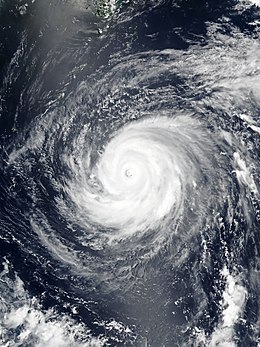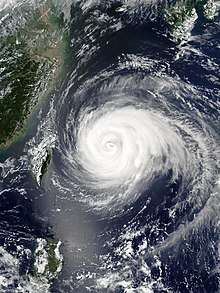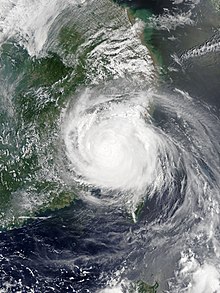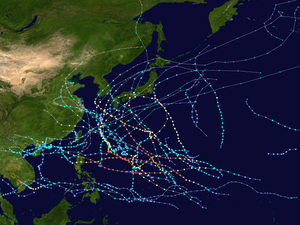Typhoon Maria (2018)
Typhoon Maria, known in the Philippines as Typhoon Gardo, was a powerful tropical cyclone that affected Guam, the Ryukyu Islands, Taiwan, and East China in early July 2018. Developing into the eighth named tropical storm of the 2018 Pacific typhoon season and passing the Mariana Islands on July 4, Maria strengthened into the fourth typhoon of the season and underwent rapid intensification the next day amid favorable environmental conditions. The typhoon reached its first peak intensity on July 6; subsequently, Maria weakened due to an eyewall replacement cycle, but it reintensified and reached a second, stronger peak intensity on July 9 with 10-minute sustained winds of 205 km/h (125 mph) and a minimum pressure of 915 hPa (mbar; 27.02 inHg). Over the next three days, it started to gradually weaken due to another eyewall replacement cycle and decreasing sea surface temperatures. After crossing the Yaeyama Islands and passing north of Taiwan on July 10, Maria ultimately made landfall over Fujian, China, early on July 11, before dissipating the next day.
| Typhoon (JMA scale) | |
|---|---|
| Category 5 super typhoon (SSHWS) | |
 Typhoon Maria at peak intensity on July 9 | |
| Formed | July 3, 2018 |
| Dissipated | July 12, 2018 |
| Highest winds | 10-minute sustained: 195 km/h (120 mph) 1-minute sustained: 270 km/h (165 mph) |
| Lowest pressure | 915 hPa (mbar); 27.02 inHg |
| Fatalities | 2 total |
| Damage | $628 million (2018 USD) |
| Areas affected | Mariana Islands, Ryukyu Islands, Taiwan, China |
| Part of the 2018 Pacific typhoon season | |
Early in its lifetime, Maria brought tropical-storm-force winds to Guam, damaging aircraft at Anderson Air Force Base and knocking out power across the island. Damage in Guam was valued at US$150,000. On July 10, Maria brought strong winds to Okinawa Prefecture, inflicting significant crop damage. Losses in the prefecture reached JP¥853.7 million (US$7.69 million).[nb 1] Simultaneously, Maria produced heavy rains and strong winds across Taiwan, killing one and injuring eight. Power to nearly 60,000 households was cut and agricultural damage was around NT$1.3 million (US$43,000). From landfall to dissipation, Maria impacted the Chinese provinces of Fujian, Zhejiang, Jiangxi, and Hunan with flooding rain and gusty winds. At least 510,000 people in coastal regions evacuated and one person was killed in Jiangxi. Around 9,300 houses and over 37,000 hectares (91,000 acres) of croplands were damaged. Schools and workplaces were closed in parts of Fujian and more than 200 flights were cancelled. Train and ferry services were also disrupted. Power outages were widespread in Fujian, where more than 320,000 customers lost power. Economic losses across China were about CN¥4.16 billion (US$620 million).
Meteorological history

On July 3, the Japan Meteorological Agency (JMA) declared that a tropical depression had formed at 00:00 UTC about 500 km (310 mi) southeast of Guam.[1][nb 2] The broad system tracked northwest around a subtropical ridge to its north as it began to consolidate,[3] with the United States-based Joint Typhoon Warning Center (JTWC) also determining that the system had become a tropical depression at 12:00 UTC.[4] Amid rather favorable environmental conditions encompassing high sea surface temperatures of 30–31 °C (86–88 °F), low to moderate wind shear, and enhanced outflow provided by a nearby tropical upper tropospheric trough,[5] the system intensified modestly, with the JTWC assessing that it became a tropical storm at 00:00 UTC on July 4.[4] The JMA also upgraded the depression to a tropical storm 12 hours later and named the system Maria.[1] On July 5, Maria began to rapidly intensify as it developed an eye feature.[6] The satellite presentation of the cyclone improved drastically over the next 24 hours, with the eye contracting to a diameter of 20 km (13 mi). The JTWC assessed that Maria became a super typhoon at 00:00 UTC on July 6,[7] possessing maximum sustained winds of 250 km/h (155 mph).[4][nb 3] Immediately after, Maria began to undergo an eyewall replacement cycle, with concentric eyewalls visible on microwave satellite imagery.[9] The JMA, however, assessed that Maria continued to strengthen to reach an initial peak intensity at 12:00 UTC with winds of 195 km/h (120 mph) and a central pressure of 925 hPa (mbar; 27.32 inHg).[1]

Some weakening took place on July 7 as Maria went through the eyewall replacement cycle, with the JTWC assessing that Maria had dropped below super typhoon strength.[4] A developing high-pressure area to Maria's northwest caused the system's forward motion to decrease while the inner eyewall dissipated and the outer eyewall began to contract.[10] However, Maria's new position with respect to a tropical upper tropospheric trough restricted outflow and prevented the storm from restrengthening immediately.[11] More substantial reintensification occurred on July 8 as Maria began to accelerate northwest once again and the system regained super typhoon strength at 00:00 UTC.[12] The JTWC judged Maria to have reached its peak intensity at 12:00 UTC on July 8 with winds of 270 km/h (165 mph), equivalent to Category 5 status on the Saffir–Simpson scale.[4] Displaying a well-defined 37 km (23 mi) wide eye, the system maintained an impressive satellite presentation into July 9,[13] when the JMA estimated Maria reached peak intensity with winds of 205 km/h (125 mph) and a minimum pressure of 915 hPa (mbar; 27.02 inHg).[1]
Late on July 9, Maria developed concentric eyewalls once again, indicating another eyewall replacement cycle was underway. Combined with decreasing upper oceanic heat content along the cyclone's path, Maria began to weaken steadily as it turned to the west-northwest.[14] At 21:00 UTC on July 9, Maria entered the Philippine Area of Responsibility and received the local name Gardo.[15] As the system passed north of Taiwan on July 10, frictional effects with the island's mountains as well as increasing northerly wind shear further weakened the cyclone.[16] At 01:10 UTC on July 11, Maria made landfall over the Huangqi Peninsula of Lianjiang County, Fuzhou in Fujian, China.[17] At the time, the system possessed 10-minute sustained winds of 155 km/h (100 mph) and 1-minute sustained winds of 175 km/h (110 mph). Rapid weakening took place once Maria moved inland, with the storm degrading to a tropical depression by 18:00 UTC. The remnant system continued inland and dissipated over Hubei before 00:00 UTC on July 13.[4][1]
Preparations and impact
Guam
Maria damaged a number of KC-135 aircraft in Andersen Air Force Base when passing near Guam as a tropical storm on July 5.[18] Several flights to and from the island were cancelled.[19] An islandwide power outage occurred on July 5 after gusty winds downed power lines, and the local weather radar was knocked out. Economic losses on the island were estimated at US$150,000.[20]
Ryukyu Islands
As a weakening typhoon, Maria made a direct hit on Miyakojima, Okinawa Prefecture, on July 10.[21] On that day, schools in Miyakojima were closed,[22] while flights to and from Miyako Airport and New Ishigaki Airport were cancelled. Ferry services connecting Miyakojima and Ishigaki Island with the surrounding islands were suspended for ten days.[23] The sugarcane crop suffered severe wind damage, with some fields in Miyakojima reporting that up to 70 percent of their crops had been damaged.[24] Total damage in Okinawa Prefecture was about JP¥853.7 million (US$7.69 million), of which nine-tenths came from the sugarcane crop. Other crops affected included pineapple, mango, millet, and okra. Damage to infrastructure was limited, reaching JP¥6.75 million (US$60,800) in Kumejima.[25]
Taiwan
As Maria passed north of Taiwan, heavy rain and gusty winds impacted the island. Workplaces and schools were closed on July 10 and resumed operations on July 11. Services along the Taiwan High Speed Rail were interrupted by the adverse weather conditions.[26][27] The Forestry Bureau closed 14 national forest recreational areas from July 10–12.[28] A man in New Taipei City sustained fatal head injuries after losing his balance when inspecting his windows.[29] Seven men and a woman were injured in northern Taiwan by falling branches. Strong winds caused 59,485 households to lose power, though the situation was mostly resolved by July 11. Agricultural damage in Taiwan was valued at NT$1.3 million (US$43,000).[30] The typhoon also eroded away part of Huaping Islet, causing its shape to now resemble a two-humped camel instead of a one-humped camel.[31]
East China

Ahead of Typhoon Maria, authorities initiated evacuations in coastal parts of Fujian and Zhejiang provinces. By July 11, at least 226,600 people were evacuated in Fujian,[32] while in Zhejiang, about 390,000 people were moved to safety, including 270,000 people from Wenzhou. In both provinces, fishing boats were ordered to return to port; the Port of Xiamen received 851 vessels, while 25,000 boats sought shelter in Zhejiang. Offshore fish farms in Fujian were closed and over 27,600 workers returned to shore. Ferry services between Xiamen and Kinmen were suspended. At least 200 train services in and out of Fujian were halted, while 206 flights to and from Zhejiang were cancelled. Across Fujian, 7,865 schools were closed and works at 4,439 construction sites were stopped. In Fuzhou, the provincial capital of Fujian, all schools and factories were closed on July 11.[33][34][35]
Upon landfall in Lianjiang County on July 11, Typhoon Maria became the strongest July typhoon to make landfall in Fujian.[17] Maria brought heavy rains and gusty winds to Fujian, Zhejiang, Jiangxi, and Hunan, affecting 1.424 million people and causing direct economic losses of CN¥4.16 billion (US$620 million). A peak rainfall total of 313 mm (12.3 in) was recorded at Lishui, Zhejiang, while a peak gust of 59.3 m/s (213 km/h; 133 mph) was observed at Sansha in Xiapu County, Fujian. Storm surge from Maria combined with the astronomical high tide to create tides exceeding warning levels by up to 0.93 m (3.1 ft). A tide gauge at Shacheng in Fuding, Fujian observed a record high tide of 4.4 m (14.4 ft) above mean sea level.[36] Across Fujian and Zhejiang, about 37,300 hectares (92,000 acres) of cropland suffered damage, of which 2,500 hectares (6,200 acres) was completely destroyed. One person was killed in Ji'an, Jiangxi province. About 800 people in Zhejiang were rescued by emergency services. In Fujian, 200 houses were damaged to varying degrees, while in Zhejiang, 8,800 houses were damaged and another 300 were destroyed.[17] Widespread power outages occurred in Fujian: over 86,000 customers in Lianjiang County and another 240,000 customers in Fuzhou lost power. Knee-deep flooding occurred in some residential areas in Fuzhou, where the police deployed 1,623 personnel to assist in flood control efforts. Fujian's water infrastructure suffered CN¥76 million (US$11.4 million) worth of damage.[32] Communications in Fujian were severely disrupted, with 2,901 base stations taken offline and 315 km (196 mi) of networking cables damaged. Authorities deployed 11,000 personnel across the province to conduct repairs.[37] In Ningde, direct economic losses reached CN¥959 million (US$143 million). At least 40 houses in the city collapsed and 184 businesses were shut.[38][32] Around 2,000 trees in Ningde were damaged by strong winds.[39]
See also
- Other tropical cyclones named Maria
- Other tropical cyclones named Gardo
- Typhoon Sinlaku (2002) – passed north of Taiwan and made landfall in Zhejiang in September
- Typhoon Saomai (2006) – most powerful typhoon on record to impact East China
- Typhoon Soulik (2013) – July system that hit northern Taiwan and Fujian
- Typhoon Nesat (2017) – another July system that hit Taiwan and Fujian
Notes
- All currencies are converted to United States Dollars using XE Currency Converter.
- The Japan Meteorological Agency is the official Regional Specialized Meteorological Center for the western Pacific Ocean.[2]
- Wind estimates from the JMA and most other basins throughout the world are sustained over 10 minutes, while estimates from the JTWC are sustained over 1 minute. On average, 1-minute winds are about 12% higher than 10-minute winds.[8]
References
- "RSMC Tropical Cyclone Best Track Name 1808 Maria (1808)". Japan Meteorological Agency. August 29, 2018. Archived from the original on August 29, 2018. Retrieved June 27, 2020.CS1 maint: unfit url (link)
- "Annual Report on Activities of the RSMC Tokyo – Typhoon Center 2000" (PDF). Japan Meteorological Agency. February 2001. p. 3. Archived (PDF) from the original on October 31, 2015. Retrieved July 29, 2017.
- "Prognostic Reasoning for Tropical Depression 10W (Ten) Warning Nr 02". Joint Typhoon Warning Center. July 3, 2018. Archived from the original on July 3, 2018. Retrieved June 27, 2020.CS1 maint: unfit url (link)
- Chu, J. H.; Levine, A.; Daida, S.; Schiber, D.; Fukada, E.; Sampson, C. R. (2019). "Western North Pacific Ocean Best Track Data 2018". Joint Typhoon Warning Center. Retrieved June 27, 2020.
- "Prognostic Reasoning for Tropical Depression 10W (Ten) Warning Nr 06". Joint Typhoon Warning Center. July 4, 2018. Archived from the original on July 4, 2018. Retrieved June 27, 2020.CS1 maint: unfit url (link)
- "Prognostic Reasoning for Typhoon 10W (Maria) Warning Nr 11". Joint Typhoon Warning Center. July 5, 2018. Archived from the original on July 5, 2018. Retrieved June 27, 2020.CS1 maint: unfit url (link)
- "Prognostic Reasoning for Super Typhoon 10W (Maria) Warning Nr 14". Joint Typhoon Warning Center. July 6, 2018. Archived from the original on July 6, 2018. Retrieved June 27, 2020.CS1 maint: unfit url (link)
- Landsea, Chris (April 21, 2006). "D4) What does "maximum sustained wind" mean ? How does it relate to gusts in tropical cyclones ?". Atlantic Oceanographic and Meteorological Laboratory. Archived from the original on February 2, 2017. Retrieved May 1, 2020.CS1 maint: unfit url (link)
- "Prognostic Reasoning for Super Typhoon 10W (Maria) Warning Nr 15". Joint Typhoon Warning Center. July 6, 2018. Archived from the original on July 6, 2018. Retrieved June 27, 2020.CS1 maint: unfit url (link)
- "Prognostic Reasoning for Typhoon 10W (Maria) Warning Nr 18". Joint Typhoon Warning Center. July 7, 2018. Archived from the original on July 7, 2018. Retrieved June 27, 2020.CS1 maint: unfit url (link)
- "Prognostic Reasoning for Typhoon 10W (Maria) Warning Nr 21". Joint Typhoon Warning Center. July 7, 2018. Archived from the original on July 8, 2018. Retrieved June 27, 2020.CS1 maint: unfit url (link)
- "Prognostic Reasoning for Super Typhoon 10W (Maria) Warning Nr 22". Joint Typhoon Warning Center. July 7, 2018. Archived from the original on July 8, 2018. Retrieved June 27, 2020.CS1 maint: unfit url (link)
- "Prognostic Reasoning for Super Typhoon 10W (Maria) Warning Nr 25". Joint Typhoon Warning Center. July 8, 2018. Archived from the original on July 10, 2018. Retrieved June 27, 2020.CS1 maint: unfit url (link)
- "Prognostic Reasoning for Typhoon 10W (Maria) Warning Nr 29". Joint Typhoon Warning Center. July 9, 2018. Archived from the original on July 10, 2018. Retrieved June 27, 2020.CS1 maint: unfit url (link)
- "'Gardo' seen to bring monsoon rains over MIMAROPA, Western Visayas". The Philippine Star. July 10, 2018. Retrieved June 27, 2020.
- "Prognostic Reasoning for Typhoon 10W (Maria) Warning Nr 33". Joint Typhoon Warning Center. July 10, 2018. Archived from the original on July 10, 2018. Retrieved June 27, 2020.CS1 maint: unfit url (link)
- "强台风"玛莉亚"造成损失近30亿元" (in Chinese). Heilongjiang Province Commission for Disaster Reduction. July 13, 2018. Retrieved June 27, 2020. Alt URL
- Insinna, Valerie (July 6, 2018). "Typhoon in Guam damages several KC-135s". Defense News. Retrieved July 9, 2018.
- Kotwal, Swetha; Williams, Dana (July 5, 2018). "Tropical Storm Maria topples trees, knocks out power". Pacific Daily News. Retrieved June 27, 2020.
- "Guam Event Reports: Tropical Storm Maria". National Climatic Data Center. 2018. Retrieved February 28, 2019.
- Masters, Jeff (July 10, 2018). "Category 3 Typhoon Maria Batters Miyakojima and Taiwan; China Next". Weather Underground. Retrieved June 16, 2018.
- "台風8号:宮古島地方に暴風警報 瞬間70m、夕方にかけ最接近か". Okinawa Times (in Japanese). July 10, 2018. Retrieved June 14, 2020.
- "「非常に強い」台風8号 宮古島に接近". News24 (in Japanese). July 10, 2018. Retrieved June 14, 2020.
- "春植え被害一部で深刻/サトウキビ". Miyako Mainichi Shinbun (in Japanese). July 19, 2018. Retrieved June 16, 2020.
- "台風8号被害8億537万円 生育期のキビが9割 沖縄県内農林水産業" (in Japanese). Ryūkyū Shimpō. July 12, 2018. Archived from the original on July 12, 2018. Retrieved July 13, 2018.
- "Typhoon Maria halts work, classes in Taiwan". Xinhua. July 10, 2018. Retrieved June 27, 2020.
- Green, David (July 11, 2018). "Taiwan Spared Major Damage by Typhoon Maria". The News Lens. Retrieved June 27, 2020.
- Liao, George (July 12, 2018). "14 national forest recreational areas across Taiwan closed during Typhoon Maria reopened". Taiwan News. Retrieved June 27, 2020.
- Everington, Keoni (July 11, 2018). "Fatal fall in New Taipei first reported death from Typhoon Maria in Taiwan". Taiwan News. Retrieved June 27, 2020.
- Everington, Keoni (July 11, 2018). "1 dead, 8 injured from Typhoon Maria in Taiwan". Taiwan News. Retrieved June 27, 2020.
- 林欣漢 (August 4, 2018). "花瓶嶼崩塌 單峰駝變雙峰". Liberty Times (in Chinese). Retrieved June 27, 2020.
- Zhou Jiaquan (July 12, 2018). "Typhoon Maria inflicts US$82 million in damage on eastern China". South China Morning Post. Retrieved June 27, 2020.
- "Typhoon Maria makes landfall in east China's Fujian". Xinhua. July 12, 2018. Retrieved June 27, 2020.
- "台风"玛莉亚"登陆福建连江 相关地区部门全力应对" (in Chinese). Government of the People's Republic of China. July 12, 2018. Retrieved June 27, 2020.
- "受台风"玛莉亚"影响 厦金航线全线停航" (in Chinese). Government of the People's Republic of China. July 11, 2018. Retrieved June 27, 2020.
- China Meteorological Administration (November 5–9, 2018). Member Report of China (PDF). ESCAP/WMO Typhoon Committee. ESCAP/WMO Typhoon Committee. pp. 5–6, 14. Archived (PDF) from the original on December 4, 2018. Retrieved June 7, 2020.
- "通信业全力做好抗击台风"玛莉亚"通信保障" (in Chinese). Government of the People's Republic of China. July 13, 2018. Retrieved June 27, 2020.
- Mo Hong'e (July 12, 2018). "City suffers $143 million economic loss from Typhoon Maria". China News Service. Retrieved June 27, 2020.
- "Typhoon Maria wreaks havoc along China's east coast". Al Jazeera. July 11, 2018. Retrieved June 27, 2020.
External links
| Wikimedia Commons has media related to Typhoon Maria (2018). |
- JMA General Information of Typhoon Maria (1808) from Digital Typhoon
- JMA Best Track Data of Typhoon Maria (1808)
- 10W.MARIA from the U.S. Naval Research Laboratory
